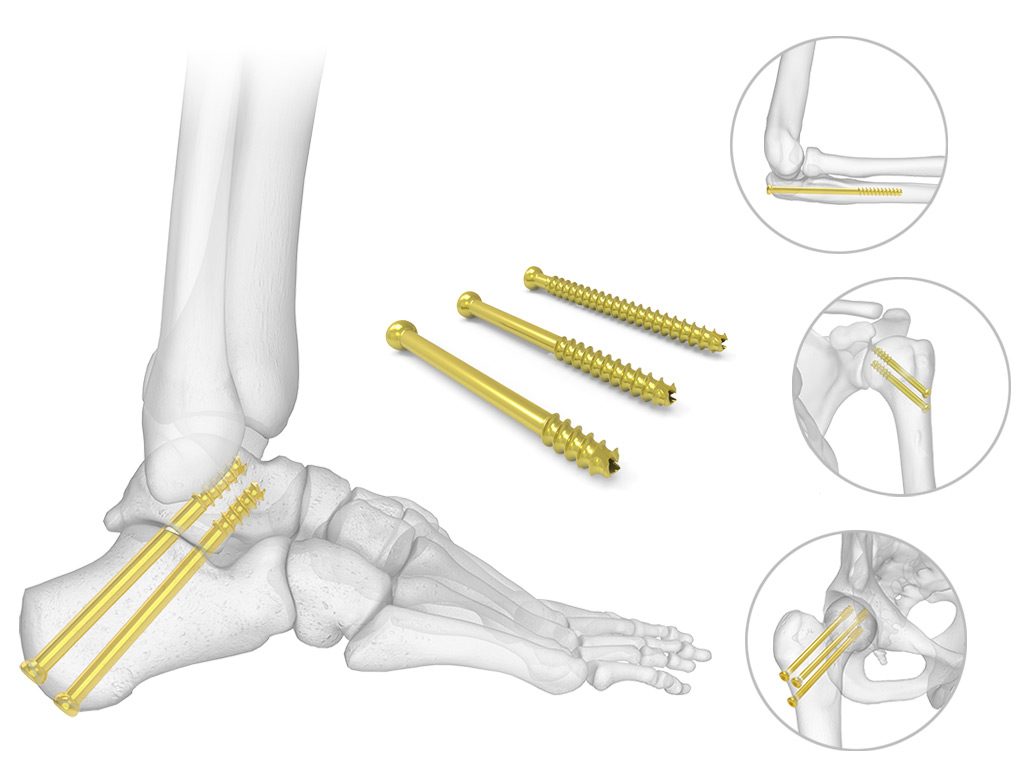
Cannulated Screw System
March 27, 2018
Overview The Acumed Cannulated Screw System is intended for fixation of fractures, fusions, and osteotomies of large and small bones appropriate for the size of the device. All screws are cannulated in order to be used over a guide wire, and each screw is either partially or fully threaded using a cancellous thread form. Partially threaded screws may be used …
Overview
The Acumed Cannulated Screw System is intended for fixation of fractures, fusions, and osteotomies of large and small bones appropriate for the size of the device. All screws are cannulated in order to be used over a guide wire, and each screw is either partially or fully threaded using a cancellous thread form.
Partially threaded screws may be used to lag one bone fragment to another, where the bone fragment is captured by the threads of the screw and pulled toward the near cortex fragment on the head side of the screw.
Fully threaded screws are intended to be used to stabilize fractures with little to no compression across the fracture.
The cannulated screws and instruments also allow for minimally invasive percutaneous insertion. The Cannulated Screw System is commonly used in the hip, pelvis, knee, ankle, and foot.
Features
- Designed to Be Minimally Invasive: A study showed that minimally invasive, percutaneous screw fixation, using
6.5 mm cannulated screws, reduces length of hospital stay and cost, and enables early mobilization for tibial plateau fractures.1 - A Traditional Approach to Fracture Management: The rising cost of health care and bundled payment systems are driving the use of low-cost options like cannulated screws. In nondisplaced fractures, screws may provide equal clinical outcomes over higher cost options.
- Low-Profile Head: Designed to reduce soft tissue irritation when compared with standard screw heads.
- Reverse Cutting Flutes: Designed to assist in removal of partially threaded screws (not available on some
short-thread 4.0 mm screws). - Self-Tapping Screw Tip: Designed to facilitate insertion and may eliminate the need for tapping in some cases.
1. Sament R, Mayanger J, Tripathy S, Sen R. Closed reduction and percutaneous screw fixation for tibial plateau fractures. J Orthop Surg. 2012;20(1):37-41.
Cannulated Screws
4.0 mm cannulated screws
4.0 mm cannulated screws are included in the Ankle Plating System 3 tray in lengths of 36 mm, 42 mm, and 48 mm. Additional lengths of 4.0 mm cannulated screws are approved for use with the Ankle Plating System 3 and are housed in standalone 4.0 mm Cannulated Screw Caddies. All 4.0 mm screws use the instruments within the Ankle Plating System 3.
· Short Thread (1/3 threaded): 10-60 mm in 2 mm increments, 60-72 mm in 4 mm increments
· Long Thread (1/2 threaded): 16-60 mm in 2 mm increments, 60-72 mm in 4 mm increments
6.5 mm cannulated screws
Potential applications for the 6.5 mm screws include: tibial plateau and femoral intercondylar fractures, ankle arthrodesis, subtalar arthrodesis, and triple arthrodesis.
· Short Thread (16 mm): 30-150 mm
· Long Thread (32 mm): 45-150 mm
· Full Thread: 30-150 mm
7.3 mm cannulated screws
Potential applications for the 7.3 mm screws include: femoral neck and head fracture, acetabular fracture, sacroiliac joint disruption, and calcaneal fracture.
· Short Thread (16 mm): 30-150 mm
· Long Thread (32 mm): 45-150 mm
· Full Thread: 30-150 mm